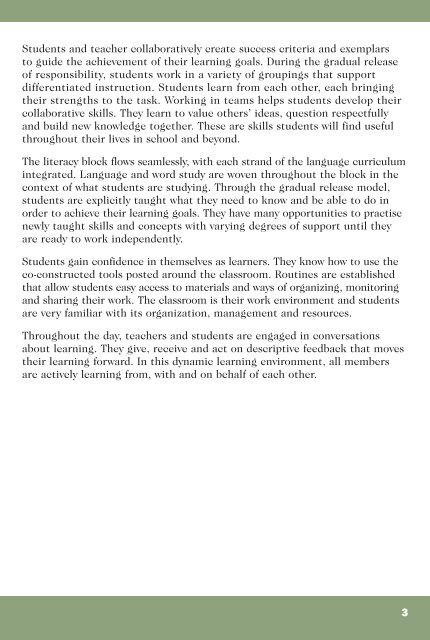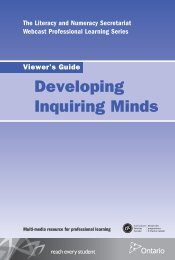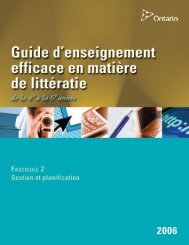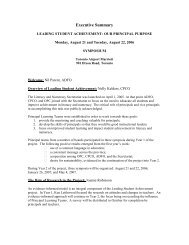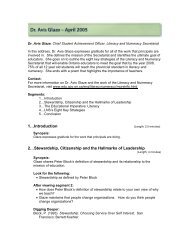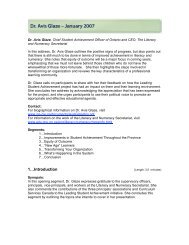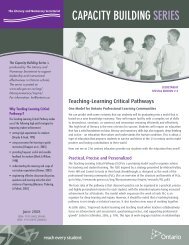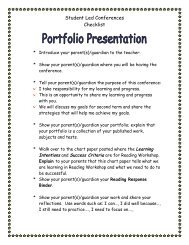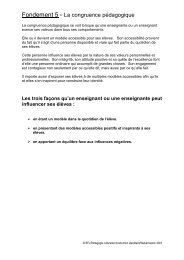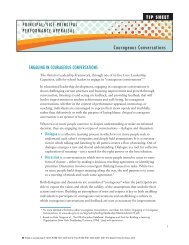Precision Teaching in the Primary Classroom Viewer's Guide
Precision Teaching in the Primary Classroom Viewer's Guide
Precision Teaching in the Primary Classroom Viewer's Guide
- No tags were found...
You also want an ePaper? Increase the reach of your titles
YUMPU automatically turns print PDFs into web optimized ePapers that Google loves.
Students and teacher collaboratively create success criteria and exemplars<br />
to guide <strong>the</strong> achievement of <strong>the</strong>ir learn<strong>in</strong>g goals. Dur<strong>in</strong>g <strong>the</strong> gradual release<br />
of responsibility, students work <strong>in</strong> a variety of group<strong>in</strong>gs that support<br />
differentiated <strong>in</strong>struction. Students learn from each o<strong>the</strong>r, each br<strong>in</strong>g<strong>in</strong>g<br />
<strong>the</strong>ir strengths to <strong>the</strong> task. Work<strong>in</strong>g <strong>in</strong> teams helps students develop <strong>the</strong>ir<br />
collaborative skills. They learn to value o<strong>the</strong>rs’ ideas, question respectfully<br />
and build new knowledge toge<strong>the</strong>r. These are skills students will f<strong>in</strong>d useful<br />
throughout <strong>the</strong>ir lives <strong>in</strong> school and beyond.<br />
The literacy block flows seamlessly, with each strand of <strong>the</strong> language curriculum<br />
<strong>in</strong>tegrated. Language and word study are woven throughout <strong>the</strong> block <strong>in</strong> <strong>the</strong><br />
context of what students are study<strong>in</strong>g. Through <strong>the</strong> gradual release model,<br />
students are explicitly taught what <strong>the</strong>y need to know and be able to do <strong>in</strong><br />
order to achieve <strong>the</strong>ir learn<strong>in</strong>g goals. They have many opportunities to practise<br />
newly taught skills and concepts with vary<strong>in</strong>g degrees of support until <strong>the</strong>y<br />
are ready to work <strong>in</strong>dependently.<br />
Students ga<strong>in</strong> confidence <strong>in</strong> <strong>the</strong>mselves as learners. They know how to use <strong>the</strong><br />
co-constructed tools posted around <strong>the</strong> classroom. Rout<strong>in</strong>es are established<br />
that allow students easy access to materials and ways of organiz<strong>in</strong>g, monitor<strong>in</strong>g<br />
and shar<strong>in</strong>g <strong>the</strong>ir work. The classroom is <strong>the</strong>ir work environment and students<br />
are very familiar with its organization, management and resources.<br />
Throughout <strong>the</strong> day, teachers and students are engaged <strong>in</strong> conversations<br />
about learn<strong>in</strong>g. They give, receive and act on descriptive feedback that moves<br />
<strong>the</strong>ir learn<strong>in</strong>g forward. In this dynamic learn<strong>in</strong>g environment, all members<br />
are actively learn<strong>in</strong>g from, with and on behalf of each o<strong>the</strong>r.<br />
3


